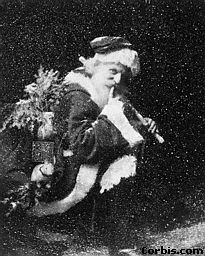| Poinsettia |
 |
 |
| The adoption of the poinsettia as the Christmas flower is relatively recent, dating rom 1828. Native to Mexico, the plant, a member of the spurge family, has small yellow flowers surrounded high up by large, tapering red leaves, which resemble petals and are often mistaken for them. At least as early as the eighteenth century, Mexicans called the plant "flower of the blessed night", because of its resemblance to the Star of Betlehem. This is the first association between the plant and Christmas. In 1828, Dr. Joel Roberts Poinsett, the first U.S. Ambassador to Mexico, brought the plant into the States, where it was renamed in his honor. By the time of his death in 1851, the poinsettia's flaming red color had already established its Christmas association. |
| Christmas Tree: 8th Century, Germany |
| The custom of a Christmas tree, begun in Germany, in the first relates how British monk and Windfrid in A.D.680) was preach tribe of Germanic Druids out vince the idolators that the oak the "Apostle of Germany" felled crushed every shrub in its path chance event can lend itself to |
| undecorated, is believe to have half of the 700s. The earliest story missionary St. Boniface (born ing a sermon on the Nativity to a side the town of Geismar. To con- tree was not sacred and inviolable, one on the spot. Toppling, it except for a small fir sapling. A numerous interpretations, and le- |
| gend has it that Boniface, attempting to win converts, interpreted the fir's survival as a miracle, concluding, "Let this be called the tree of the Christ Child". Subsequent Christmases in Germany were celebrated by planting fir saplings. We do know with greater authority that by the sixteenth century, fir trees, indoors and out, were decorated to commemorate Christmas in Germany. A forest ordinance from Ammerschweier, Alsace, dated 1561, states that "no burgher shall have for Christmas more than one bush of more than eight shoes's length". The decorations hung on a tree in that time, the earliest we have evidence of, were "roses cut of many-colored paper, apples, wafers, gilt, sugar". It is widely held belief that Martin Luther, the sixteenth-century Protestant reformer, first added lighted candles to a tree. Walking toward his home one winter evening, composing a sermon, he was awed by the brilliance of stars twinkling amidst evergreens. To recapture the scene for his family, he erected a tree in the main room and wired its branches with lighted candles. By the 1700s, the Christbaum, or "Christ tree", was a firmly established tradition. From Germany the custom spread to other parts of Western Europe. It was popularized in England only in the nineteenth century, by Prince Albert, Queen Victoria's German consort. Son of the duke of Saxe Coburg-Gotha (a duchy in central Germany), Albert had grown up decorating Christmas trees, and when he married Victoria, in 1840, he requested that she adopt the German tradition. |
| Xmas |
 |
| The familiar abbreviation for Christmas originated with the Greeks. X is the first letter of the Greek word for Christ, Xristos. By the sixteenth century, "Xmas" was popular thoughout Europe. Whereas early Christians had understood that the term merely was Greek for "Christ's mass", later Christians, unfamiliar with the Greek reference, mistook the X as a sign of disrespect, an attempt by heathen to rid Christmas of its central meaning. For several hundred years, Christians disapproved of the use of the term. Some still do. |
 |
| Santa Claus: Post--4th Century, Europe, Asia, America |
| The original Santa Claus, St. Nicholas, was born in the Turkish town of Lycia early in the fourth century. To child, he adopted a self-imposed twice-weekly fast Fridays). Then, upon the early death of his parents, life to Christ, entering a Lycian seminary. It was on a tine that he is supposed to have extended his arms sea, the first of his many miracles. Later, he would saint of sailors. At an early age, Nicholas was appoint- Asia Minor. His success in winning coverts, and his poor, incensed Roman officials. During a great he was imprisoned and tortured under orders of the ror Gaius Diocletianus. The ruler, after a reign of abruptly abdicated at age sixty in favor of the simple |
| ancient southeastern show his piety as a (on Wednesdays and he fully dedicated his boat journey to Pales- and stilled a violent become the patron ed bishop of Myra, in generosity toward the Christian persecution, despotic Roman empe- terror and profligacy, life of farming and |
| raising cabbages. This pleased many Romans and was most fortunate for Nicholas. The new emperor, Constantine (who would later convert to Christianity), freed the bishop. And when Constantine convened the first Church council at Nicaea in 325, Nicholas attended as a prominent member. He is believed to have died on December 6, 342, and eventually was adopted as the patron saint of Russia, Greece, and Sicily. Two aspects of St. Nicholas's life led to his becoming Santa Calus: His generosity was legend, and he was particularly fond of children. We know this primarily through Roman accounts of his patronage of youth, which eventually led to his becoming the patron saint of children. Throughout the Middle Ages, and well beyond, he was referred to by many names--none of them Santa Claus. Children today would not at all recognize the St. Nick who brought gifts to European children hundreds of years ago--except perhaps for his cascading white beard. He made his rounds in full red-and-white bishop's robes, complete with twin-peaked miter and crooked crozier. He was pulled by no fleet-footed reindeer, but coaxed an indolent donkey. And he arrived not late on Christmas Eve but on his Christian feast day, December 6. |